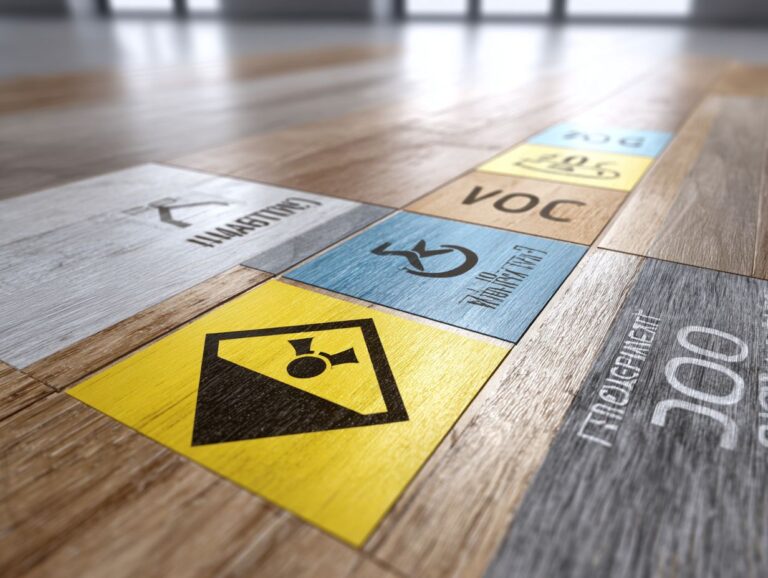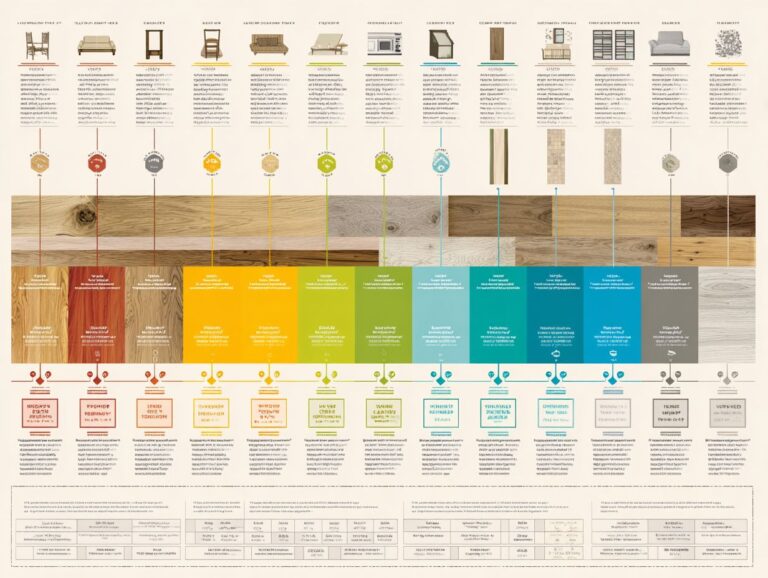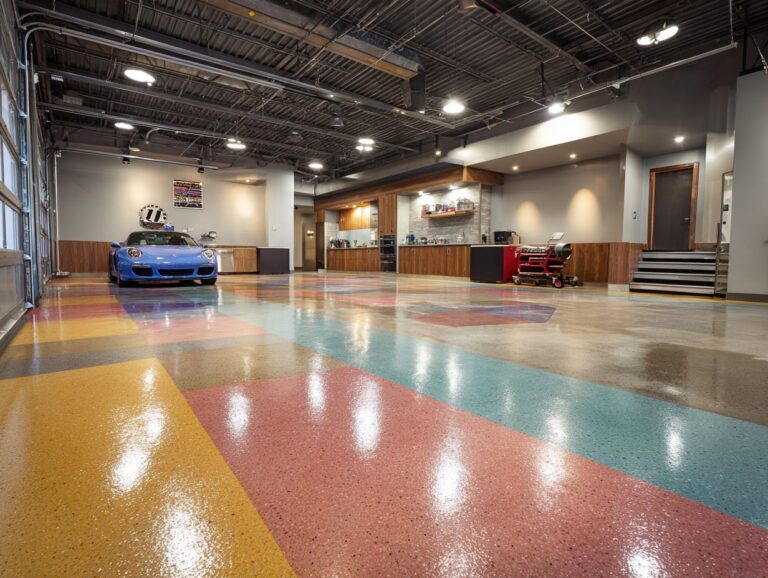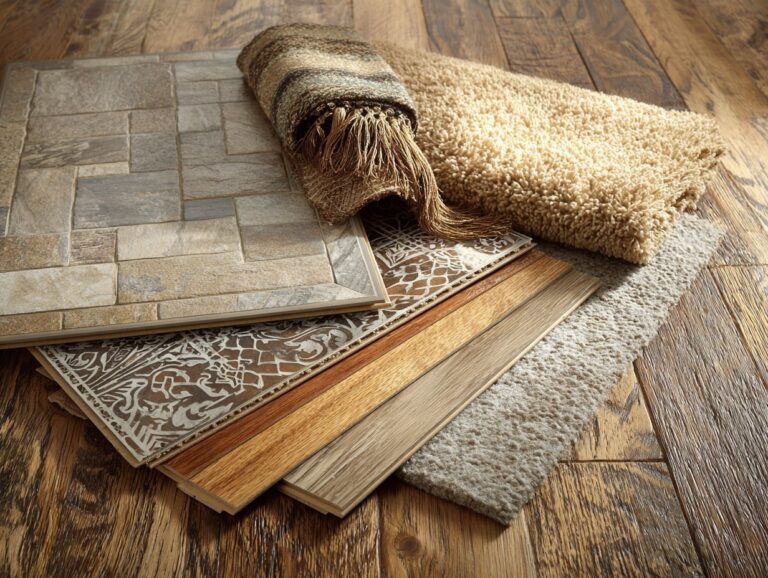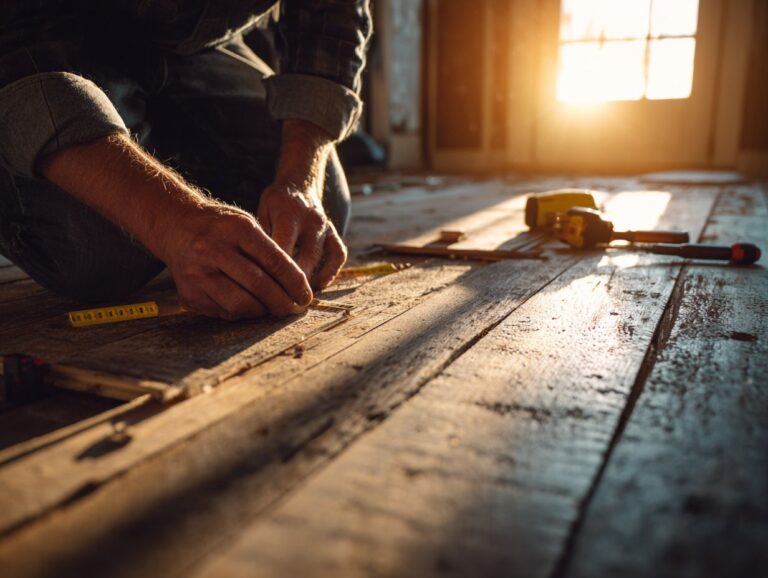Noise Reduction Flooring – Acoustic Solutions
Contents
Introduction to Noise Reduction Flooring

Key Takeaways:
Definition and Importance
Noise reduction flooring involves using certain materials and setups to reduce sound movement, especially important in places where tenants are unhappy because of noise problems.
These flooring solutions include:
- Carpet underlayment
- Acoustic vinyl
- Cork flooring
Cork flooring lowers noise levels and retains warmth, making it ideal for houses. In commercial settings like fitness studios, acoustic vinyl absorbs impacts, significantly reducing the noise from heavy foot traffic and equipment.
Using these materials helps solve tenant complaints and improves living conditions by creating a quieter and more peaceful environment.
Overview of Acoustic Solutions
Different sound solutions include products like acoustic gym flooring and eco-friendly materials that improve sound absorption while looking good.
Cork flooring is a great option for places focused on reducing noise and providing comfort, like wellness studios. Its natural thermal and acoustic properties help create a serene environment.
On the other hand, rubber flooring is highly durable and water-resistant, perfect for fitness spaces that require resilience and ease of cleaning. Both materials can be used with acoustic panels to improve sound control, adjusting to the needs of different spaces to maintain a pleasant atmosphere. As mentioned, understanding Sound Transmission Class (STC) ratings for flooring can further enhance the effectiveness of these acoustic solutions.
Acoustic Flooring Market Growth Forecast
Acoustic Flooring Market Growth Forecast
Global Market Analysis: Market Size Growth
Global Market Analysis: Lightweight Acoustic Floor Systems
The Acoustic Flooring Market Growth Forecast illustrates significant expansion prospects, driven by escalating demand for noise-reducing flooring solutions across various sectors. The data shows a full overview of the projected global market size, growth rates, and regional contributions, revealing important trends that will shape the industry’s development.
Global Market Analysis shows a notable increase in market size from $12.3 billion in 2023 to $21.7 billion by 2032. This expansion reflects a compound annual growth rate (CAGR) of 6.3% from 2025 to 2033 This shows strong demand for soundproofing in businesses, homes, and factories. The growth is fueled by rising urbanization, technological advancements, and heightened awareness of noise pollution’s impact on health and productivity.
- Lightweight Acoustic Floor Systems: This segment is set to grow from $4.3 billion in 2025 to $8.3 billion by 2035, with a CAGR of 6.7%. The demand for lightweight solutions is driven by their ease of installation and effectiveness in multi-story buildings, where reducing structure-borne noise is critical.
In terms of Regional Market Contributions, North America is projected to hold a significant 34.6% revenue share in 2025, driven by regulatory standards and the demand for high-performance building materials. Europe follows with a 21.1% share, where stringent noise regulations and a growing focus on sustainable construction practices contribute to market growth.
The data highlights the Concrete Segment accounting for 24.6% of the market in 2025. This indicates a strong preference for durable and effective solutions in noise insulation. Additionally, the Fixed Flooring segment, encompassing a variety of acoustic floor types, is expected to capture a 52.3% revenue share, reflecting its widespread adoption in construction projects.
Overall, the Acoustic Flooring Market is set for significant growth, driven by new technology and a higher focus on acoustic comfort. Companies that create new and eco-friendly products are likely to find big chances in this growing market.
Types of Noise Reduction Flooring
Different kinds of noise-reducing floors address different sound issues, providing the best results for particular user requirements and surroundings.
Carpet Flooring
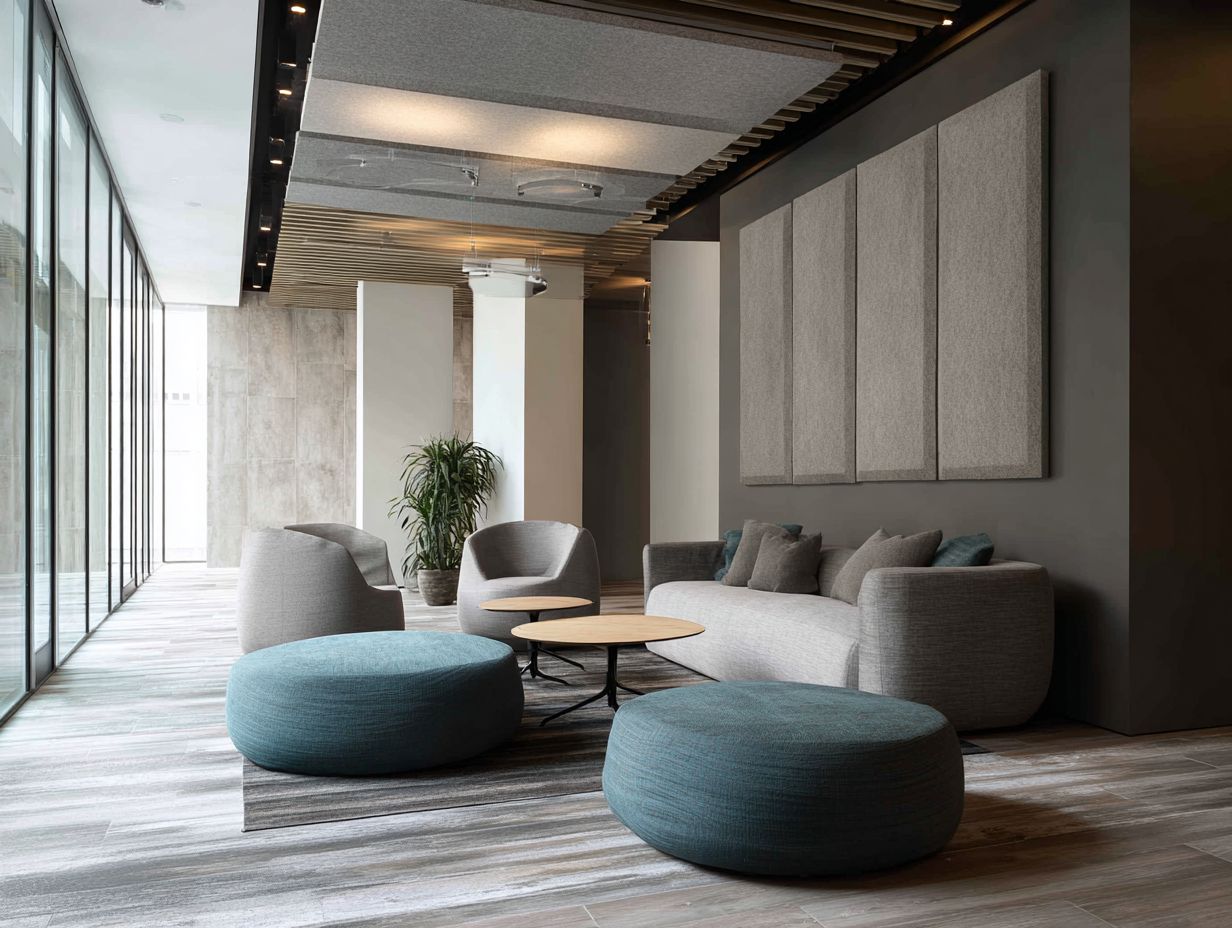
Carpet flooring is a popular choice for noise reduction, offering substantial sound absorption while enhancing comfort underfoot, particularly in residential applications.
Carpet significantly reduces noise due to its dense fibers and cushioning properties. Products like Mohawk SmartStrand have a high ability to absorb sound, effectively lowering noise levels in busy areas, making them ideal for living rooms and bedrooms.
When installing, use a thick underpad to improve performance in busy areas. Vacuum regularly and occasionally hire a professional cleaner to keep it working well and lasting longer, making it a good choice for any home.
Vinyl Flooring
Vinyl flooring is durable and muffles sound effectively, making it a practical option for businesses that require sound reduction and easy maintenance.
To reduce noise, consider using products like Armstrong SoundSense, which has a sound-absorbing layer that reduces sound transfer. Regular upkeep is important; use a pH-neutral cleaner to prevent harm to the surface.
Employing area rugs or underlays can further minimize sound impact. Implementing a schedule of weekly cleaning and occasional deep cleaning will extend the lifespan of your vinyl flooring while maintaining its noise-reducing qualities.
Picking the right vinyl product, along with regular maintenance, will create a quieter commercial space.
Laminate Flooring
Laminate flooring offers an aesthetically pleasing option that can help manage sound transmission, especially when installed with appropriate underlays for better impact absorption.
Picking the correct underlayment is important for improving sound insulation.
- Products like Roberts Super Felt ($0.35/sq. ft.) are excellent for sound absorption, while QuietWalk ($0.50/sq. ft.) also combats moisture issues, perfect for basements.
- For added benefits, consider the German-made EnviroSilence which offers both sound dampening and thermal insulation.
A well-installed underlayment decreases noise and helps your flooring last longer by giving it a firm foundation.
For the best results, install underlayment that is at least 3mm thick.
Engineered Wood Flooring
Engineered wood flooring has multiple layers that reduce noise and absorb sound, making it a practical choice for homes and offices.
The top layer is usually made from hardwood, which improves appearance and makes it last longer. Meanwhile, the core layers, often composed of plywood or high-density fiberboard, work together to minimize sound transmission.
To install, using a floating method can improve performance; this lets the material expand and contract a little without losing stability. Consider using underlayment designed specifically for sound reduction, which can further improve acoustic performance in multi-story buildings or noisy environments.
These features make engineered wood ideal for spaces like offices, apartments, or homes near busy streets.
Benefits of Noise Reduction Flooring
Installing noise-reducing floors can bring major advantages, such as better sound quality and a rise in property worth, effectively tackling usual noise problems.
Improved Acoustic Comfort
Noise reduction flooring can dramatically improve acoustic comfort, reducing ambient noise levels by up to 30%, creating more enjoyable environments for residents and tenants.
For optimal results, consider flooring options like cork, which can absorb sound effectively and reduce echo. Carpet is a good choice because studies show that soft carpets can significantly lower noise levels, making them ideal for apartments or offices.
Luxury vinyl tile (LVT) offers a stylish look while maintaining good acoustic properties.
To quantify improvements, measure decibel levels before and after installation; many users report a noticeable difference in quietness, enhancing overall comfort and peace in their spaces.
Enhanced Privacy
Better privacy is a clear benefit of noise reduction flooring, offering good sound isolation that results in happier tenants and fewer noise complaints.
To achieve this, consider using rugs or carpets designed to reduce sound, such as those from Mohawk’s SmartStrand line, which can significantly decrease noise.
Another option is cork flooring, like the options from Wicanders, known for their excellent acoustic properties. Adding an underlayment can improve soundproofing; products such as Roberts Double Sided Carpet Tape are useful for holding the layers in place.
These solutions improve the daily lives of tenants, leading to higher tenant retention and fewer empty units.
Increased Property Value
Investing in noise-reducing flooring improves living conditions and can raise property value, potentially increasing resale value by up to 10% in competitive markets.
A study by the National Association of Realtors revealed that homes with noise reduction features are 12% more appealing to buyers.
Luxury vinyl planks such as COREtec have soundproof backing that reduces noise and improves appearance. Putting an acoustic underlayment beneath hardwood or laminate floors can make them better at reducing noise, which is a budget-friendly choice.
While the average return on investment for such flooring ranges between 70-80%, the attractiveness and comfort that comes with reduced noise is what truly draws buyers in.
Key Features to Consider
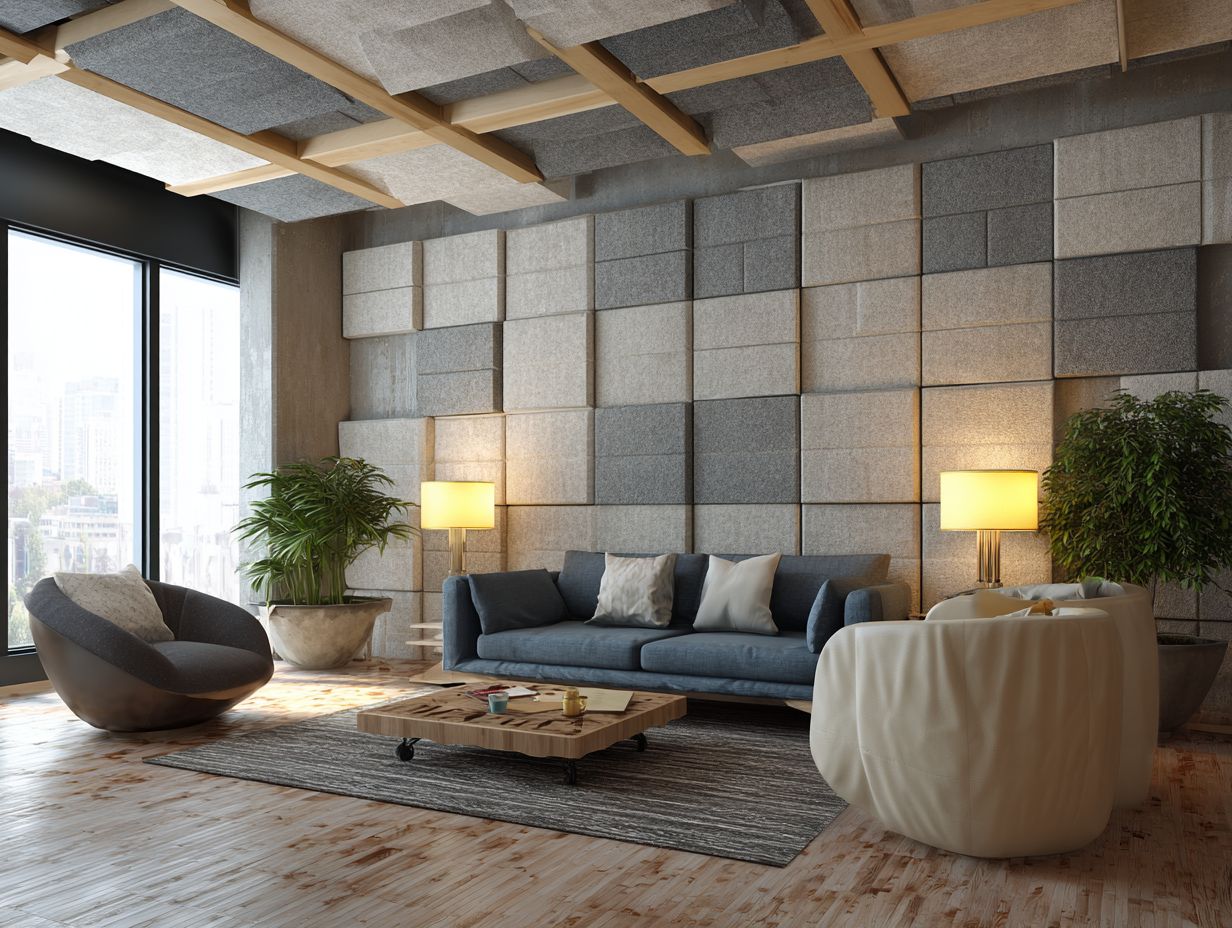
When choosing flooring that reduces noise, important factors include the thickness of the material, how well it absorbs sound, and the way it is installed, as these greatly affect how well it works.
Material Density
The thickness of a material affects how well it blocks sound. Denser materials usually block noise better, which is important in areas where noise control is very important.
For instance, concrete, with a density of about 150 lb/ft, excels at blocking sound in commercial buildings, while hardwoods like oak offer decent performance at around 45 lb/ft.
Foam underlayments, typically ranging from 2-10 lb/ft, can supplement soundproofing for laminate flooring. When selecting flooring for noise reduction, consider incorporating a combination of these materials. Learn more about Sound Transmission Class (STC) ratings to better understand how different flooring options can impact soundproofing effectiveness.
Using a thick layer under lighter materials can significantly cut down noise, making places like gyms or apartment buildings much quieter and more enjoyable.
Sound Absorption Ratings
Knowing how well a floor can absorb sound is important when choosing flooring, as it shows how much noise the floor can block.
These ratings typically range from 0.0 to 1.0, with higher values indicating better sound absorption. When evaluating flooring products, look for those that have a Noise Reduction Coefficient (NRC) of at least 0.5 for effective noise dampening.
For example, Shaw’s Resilient Vinyl Floors have an NRC of 0.60, which makes them a good choice for homes and businesses. Mohawk’s SmartStrand carpet has an NRC rating of 0.70, which makes it ideal for houses, particularly in high-traffic areas.
Installation Methods
Different installation methods can significantly affect the performance of noise reduction flooring, with professional installations often recommended for optimal results.
Having a professional install your flooring means it will be done with skill and accuracy, so it absorbs sound as best as possible. To cut down noise, hire a contractor who understands acoustic flooring to properly install the underlayment.
On the other hand, a DIY installation can be a cost-effective option, especially for click-lock vinyl, which many homeowners can install themselves within a weekend. Follow the manufacturer’s instructions for underlayment and getting the materials used to the environment’s conditions to prevent problems.
In the end, make your decision based on how much money you want to spend, how much time you have, and how comfortable you are with doing it yourself.
Installation Process
Correctly installing noise reduction flooring is essential for getting the best results. Make sure to prepare the subfloor and choose the right underlayment.
Preparation of Subfloor
Effective preparation of the subfloor is essential for noise reduction flooring installation, ensuring a flat and clean surface that promotes optimal vibration control.
- Start by gathering the necessary tools: a level, a tape measure, a floor scraper, and a vacuum.
- Begin by assessing the existing subfloor-check for uneven areas using the level. If you notice dips or high spots, use the floor scraper to remove any debris or old adhesive.
- Next, fill in lower spots with a suitable leveling compound, allowing it to dry completely before proceeding. Common mistakes include neglecting to clean the surface adequately and failing to let materials cure as directed, both of which can undermine the flooring’s performance.
Choosing the Right Underlayment
Choosing the right underlayment is important for reducing noise and absorbing impact. Options include foam and rubber, depending on what you need.
Foam underlayment is light and affordable. It offers average sound absorption, which makes it a good choice for laminate flooring.
If you’re working with hardwood, consider cork underlayment, which provides superior sound dampening while also being eco-friendly.
For areas with heavy foot traffic, rubber underlayment is ideal; it excels at absorbing impact noise and is durable against wear and tear.
Carefully assess your flooring type and anticipated usage to make an informed choice that maximizes both comfort and acoustics.
Professional vs. DIY Installation
Deciding between professional and DIY installation depends on budget considerations and the complexity of the flooring type selected, impacting long-term performance.
Professional installation usually costs between $3 and $5 per square foot. This price covers experienced workers, ensuring good results, especially for difficult surfaces like hardwood or complicated tile designs.
A 1,000-square-foot area might cost between $3,000 and $5,000 while keeping noise low and being very durable. To better understand how lifespan varies by material, consider looking into the replacement cycles of different flooring types.
On the other hand, doing it yourself can save money-$1 to $2 per square foot-but you need to know installation methods well to prevent errors.
Homeowners should weigh the risk of potential long-term issues against initial savings to determine the best approach.
Maintenance and Care
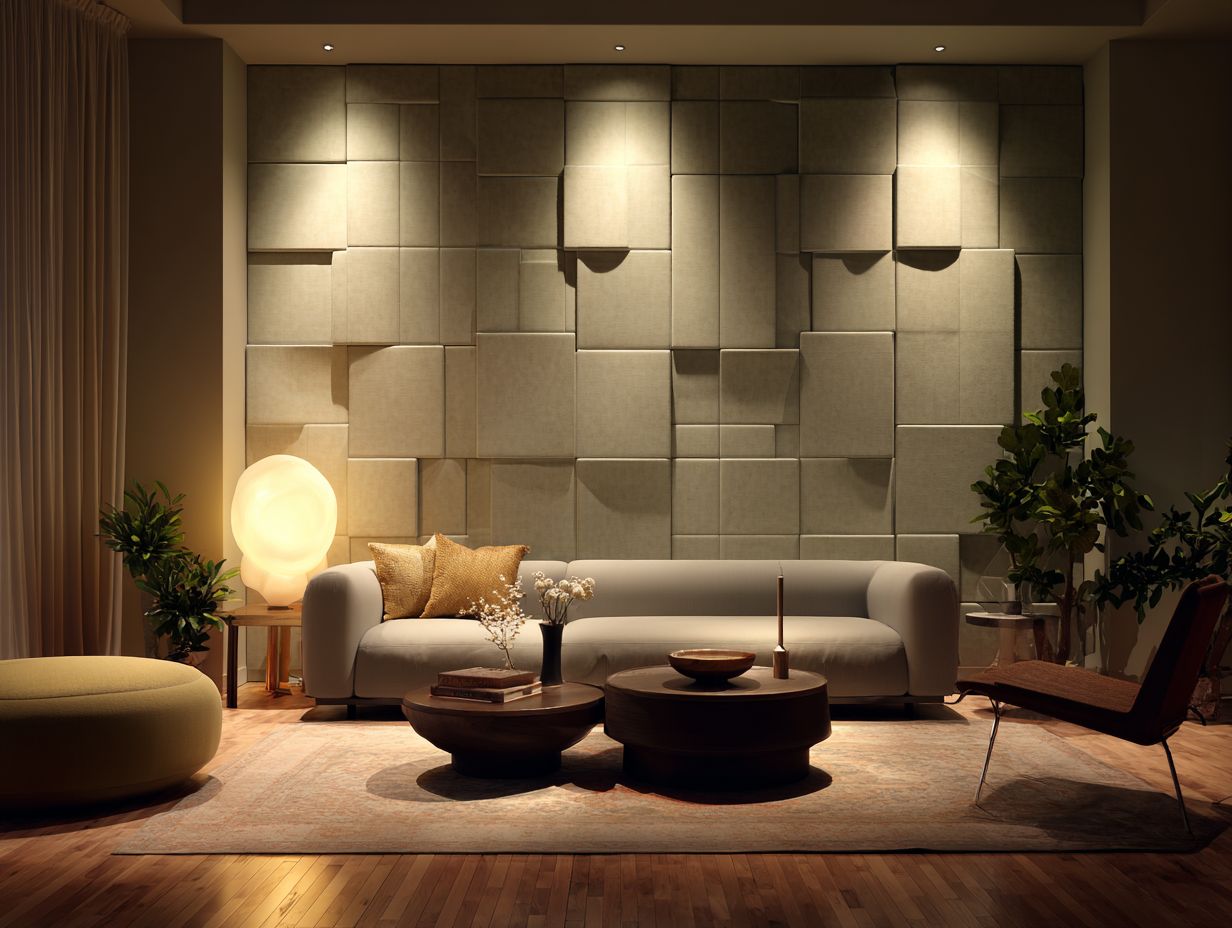
Taking care of and maintaining noise-reducing floors regularly is important to keep them working well and looking good in different places.
Cleaning Techniques
Effective cleaning techniques for noise reduction flooring include using appropriate cleaning agents and tools that do not damage the acoustic properties of the materials.
Start by using a microfiber mop to gently sweep away dust and debris, which prevents scratching. For deeper cleaning, mix a few drops of pH-neutral cleaner like Bona Hardwood Floor Cleaner with warm water, applying it sparingly with a damp mop.
Avoid harsh chemicals that can compromise sound-absorbing qualities. It’s best to clean weekly, but if there is heavy foot traffic, consider bi-weekly or monthly deep cleans.
Try out a new product on a small patch of your floor first to check if it works well with it.
Long-term Care Tips
Following long-term care suggestions can significantly extend the life and performance of noise reduction flooring, ensuring it effectively addresses sound issues.
To maintain flooring while preventing wear and tear, consider the following strategies.
- For carpet, regularly vacuum to remove dirt and use a carpet cleaner monthly to maintain its sound absorption.
- To protect hardwood floors, place rugs in high-traffic areas and reseal them every few years.
- Vinyl flooring requires damp mopping with a mild detergent to avoid buildup that can affect sound dampening.
- For tile floors, make sure the grout is sealed and clean up any spills right away to avoid stains that could harm the floor.
These actions can help extend the life and performance of your flooring.
Final Thoughts on Acoustic Solutions
In the end, knowing about the different sound options helps people choose ones that reduce noise well.
When considering acoustic solutions, evaluate materials based on their sound absorption capacity, durability, and aesthetic appeal.
For instance, felt tiles excel in absorbing sound while offering a modern look, while cork flooring provides excellent insulation and eco-friendliness.
Consider acoustic underlayment choices such as rubber or foam, which can greatly lessen noise that travels between floors.
Look at your room; if the ceilings are high, you might want products that reduce echo.
Always consider your specific needs and talk to professionals to make sure your decision matches your way of living and design tastes.
Frequently Asked Questions
What is noise reduction flooring?
Noise reduction flooring is a type of flooring that is specifically designed to reduce the amount of noise that passes through it. This is achieved through the use of special materials and construction techniques that absorb or block sound waves, creating a quieter and more peaceful environment.
Why would I need noise reduction flooring?
You may need noise reduction flooring if you live in a noisy environment, such as a busy street or a building with thin walls. This type of flooring can also be beneficial for commercial spaces, where noise levels can be a distraction or cause discomfort for employees or customers.
How does noise reduction flooring work?
Noise reduction flooring works by absorbing sound waves and reducing their ability to travel through the floor. This can be achieved through the use of materials such as cork, rubber, or acoustic underlayment, which are all known for their sound-absorbing properties. Some types of flooring may also have a thicker construction or multiple layers to block sound waves from passing through.
What are the benefits of installing noise reduction flooring?
The main benefit of noise reduction flooring is creating a quieter and more peaceful environment. This can improve overall quality of life, whether in a residential or commercial setting. Noise reduction flooring can make a space quieter, which is helpful for activities like studying or working that need focus.
Are there different types of noise reduction flooring?
There are different kinds of flooring designed to reduce noise, each with specific features and advantages. Some popular options include carpet, cork, rubber, and acoustic vinyl flooring. It is important to consider the specific needs and characteristics of your space when choosing the best type of noise reduction flooring.
Is noise reduction flooring expensive?
The cost of noise reduction flooring can vary depending on the type of flooring and the size of the space that needs to be covered. Generally, noise reduction flooring may be slightly more expensive than traditional flooring options, but the benefits in terms of noise reduction and improved acoustic performance often make it a worthwhile investment. There are also cost-effective choices, like acoustic padding that can be placed under current flooring.
